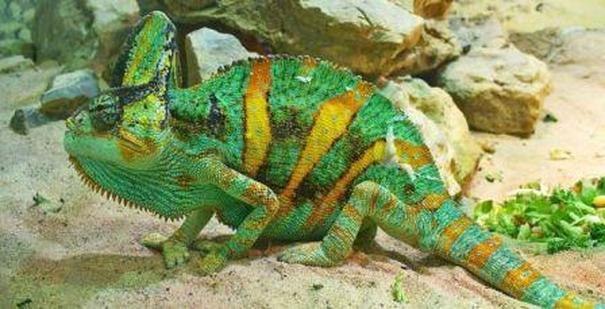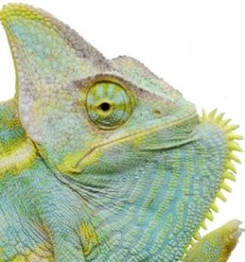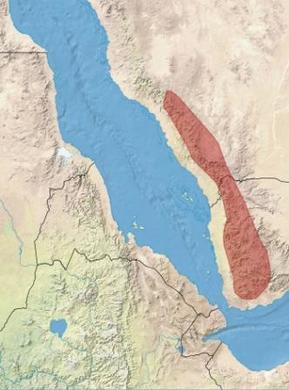Veiled ChameleonChamaeleo calyptratus |

Custom Search
|
|
The Veiled Chameleon (Chamaeleo calyptratus) is a species of chameleon endemic to the southwestern Arabian Peninsula, found across the border region between Yemen and southern Saudi Arabia.
In their native habitat, these chameleons are found mostly in the dry plateaus and higher deserts and in high altitudes of the mountainous regions, inland river valleys or wadis. The species is found at an elevation of up to 3000 feet. These reptiles inhabit many arboreal habitats, such as woodlands, forests, tree-lined roadways and gardens. Like other chameleon species, the Veiled Chameleon is an arboreal lizard, which means they live in the bush and shrubs near the ground or higher up in the trees. Unlike most other chameleon species, the veiled chameleon can tolerate a wider temperature range. But these chameleons do prefer to live in habitats with temperatures ranging from 75 to 95 degrees F. The species has also established populations in both Florida and Hawaii, most probably from released or escaped captive specimens. The species is also known by other common names, such as Yemen chameleon and cone-head chameleon, referring to its prominent head crest.

The Veiled Chameleon is a sexually dimorphic species, meaning that adult males and females look very different and are therefore easily distinguishable.
Adult males are somewhat larger than females, reaching between 17 and 24 inches (43-61 cm) in total length. Females are shorter, reaching only about 14 inches (35 cm), but they do have a thicker body. Their characteristic head crest or casque is also larger in males reaching about 2 inches (5 cm) in the largest adult males. Males also possess a heel spur even when they are only hatchlings. Males are brighter than females, with their body covered in a variety of shades of green with 3 to 5 yellow, orange or blue bands. They also have some mottling ranging in color from dark green, blue, red, orange, brown, yellow and many other. Females have a smaller crest and are much less colorful, with a green body coloration covered with white, tan, orange, or yellow mottling. However, during breeding season females develop quite striking blue markings around their head and legs. Hatchlings have a pastel green coloration developing the stripes as they mature. These tree-dwellers use their flattened, arched body shape that resembles a leaf combined with their coloration as camouflage so they blend in with their surroundings. The veiled chameleon coloration can be affected by many external factors, including stress or social status. It was in the spring of 1990 that the first imported Veiled Chameleons arrived in the US. Just a few months later in 1991, the San Diego Zoo has successfully bred them. This helped to establish their reputation has an easy to breed and care species. Today the veiled chameleon is the most common Chamaeleo species found in the exotic pet trade. Subspecies / Taxonomy / Etymology
There are 2 subspecies recognized. The Veiled Chameleon was first described by Peters in 1870 as Chamaeleo calyptratus, he also described a second subspecies, the Short-casqued Veiled Chameleon (Chamaeleo calyptratus). Veiled Chameleon (Chamaeleo calyptratuswas - Peters, 1870) - From the 2 subspecies this one has a higher crest or casque. Short-casqued Veiled Chameleon (Chamaeleo calyptratus calcarifer - Peters, 1871) - As its name implies this subspecies has a smaller crest or casque than that of the Veiled Chameleon subspecies. Diet / Feeding The veiled chameleon eats mostly insects, so it is often considered an insectivore species. Their insect diet includes crickets, mantids, locusts, waxworms, cockroaches, silkworms, mealworms, and grasshoppers. They show a preference for certain types of prey, with green insects appearing as favorites. But they are also one of the few chameleons that will also eat plant matter such as leaves, fruits or blossoms. They do this during the dry season or during droughts as a source of water. They will also drink drops of water found on leaves. Sometimes they will even feed on small lizards, small birds, and mammals, so maybe we should regard them as omnivores. The veiled chameleon is an ambush predator, lying still for long periods of time, just waiting for an unsuspecting insect to wander close by. Being an arboreal species these chameleons are equipped with a prehensile tail, to help them balance in the trees while feeding. Like other chameleons, they are able to capture prey at a distance by projecting their sticky tongue, which measures one and a half times their own body length. They also use their tongue for smell and taste. Reproduction While some chameleon species give birth to live young the veiled chameleon lays eggs. Local climatic conditions affect the breeding season, drier areas it takes place It in September and October while in areas with substantial rainfall it may take place all year round. Males are always very territorial, particularly during mating season. They will fight with each other, flatten their body, inflate the throat, headbutt and even bite causing wounds. The loser will darken in color and puff down to concede defeat. Females also fight off unwanted males during this time. During courtship males will display for females, engaging in such behaviors as "chin rubs" and "head rolls". During the mating season, the female turns from their normal light green color to a blackish-green coloration covered with blue and yellow spots within 18 hours of a successful mating. Mating may occur up to 3 times a year. After a gestation period of 20 to 30 days, after which, the female lays a clutch of 30 to 95 eggs in a hole dug in the ground. While in the eggs the embryos are dormant, the increasing temperatures in the underground nest kick-start their development. The eggs, which are white, oval in shape and have a tough skin, hatch after an incubation period of around 6 months. At birth, the hatchlings are pastel green in color and as they grow they develop stripes, they measure about 2 to 3 inches in length. Veiled chameleon females can store sperm, so they are capable of fertilizing more than 1 clutch from a single breeding. They may lay another clutch 3 or 4 months after the first one. The veiled chameleon reaches sexual maturity 4 to 5 months after birth with a length around of 8 to 12 inches (20 to 30cm). Conservation status and major threats The Veiled Chameleon is listed as a least concern species by the IUCN. They have a wide distribution and has evolved to adapt to many different habitats, including those disturbed and modified by humans. The species is also listed on CITES Appendix II. They were and still are collected for the exotic pet trade, but their exportation has declined in recent years because most specimens in the pet trade nowadays are captive-bred individuals. For the time being, there are no perceived major threats impacting this chameleon species. Some localized threats to their habitat, come from road and other associated infrastructures development, which may lead to an increase in road kill. Other threats include growing demand for chameleon body parts, sold as souvenirs to tourists or to be used in magic rituals by locals. Local people also believe that throwing live chameleons into a fire brings them good luck. They are considered an invasive species in Hawaii and Florida, where they have established breeding populations.
|
Scientific classification
Kingdom: Animalia Phylum: Chordata Class: Reptilia Order: Squamata Suborder: Iguania Family: Chamaeleonidae Genus: Chamaeleo Species: C. calyptratus |


